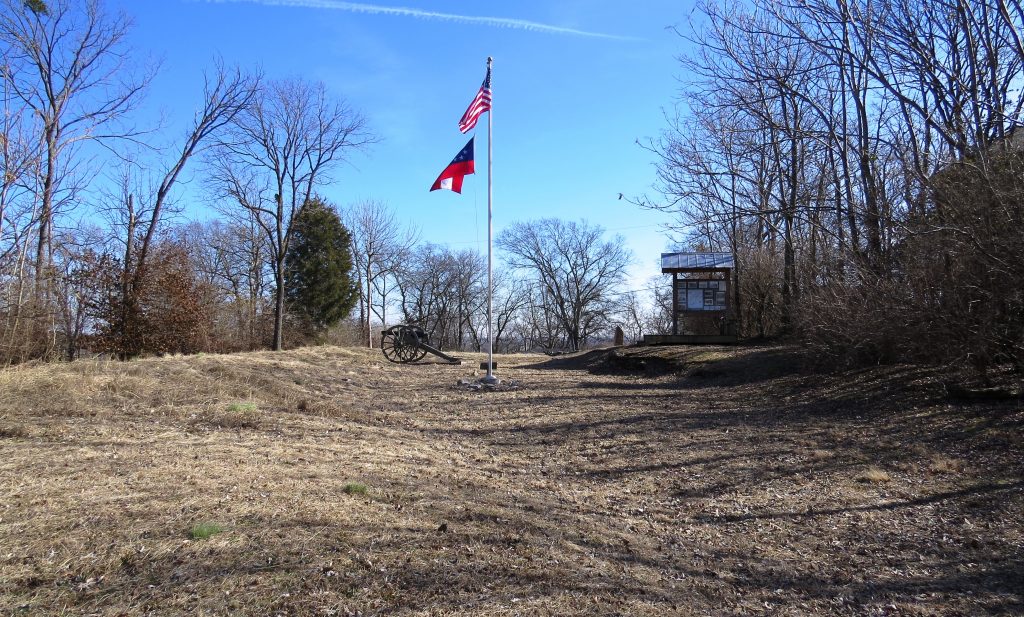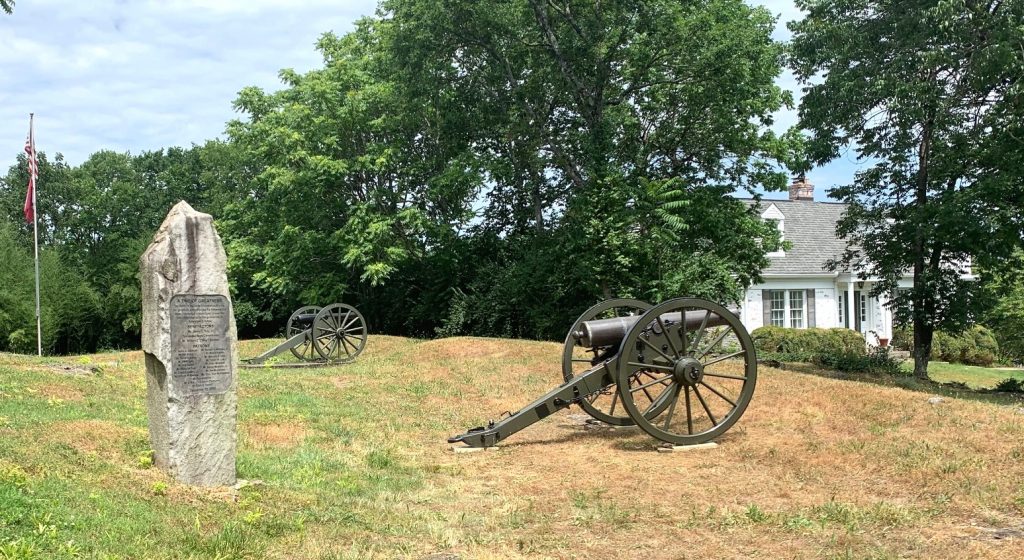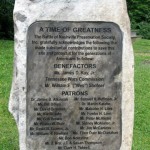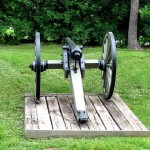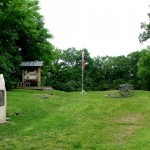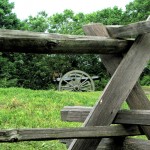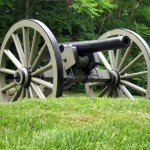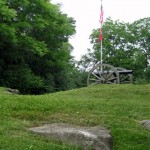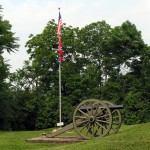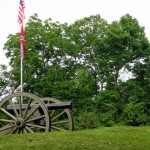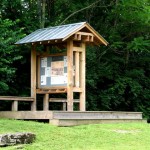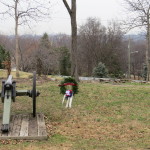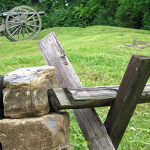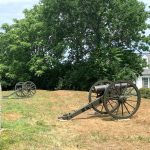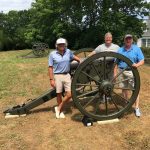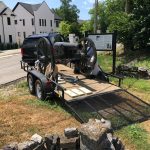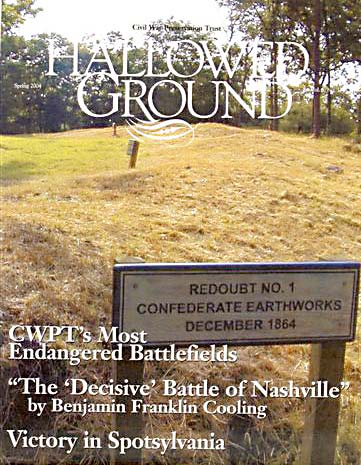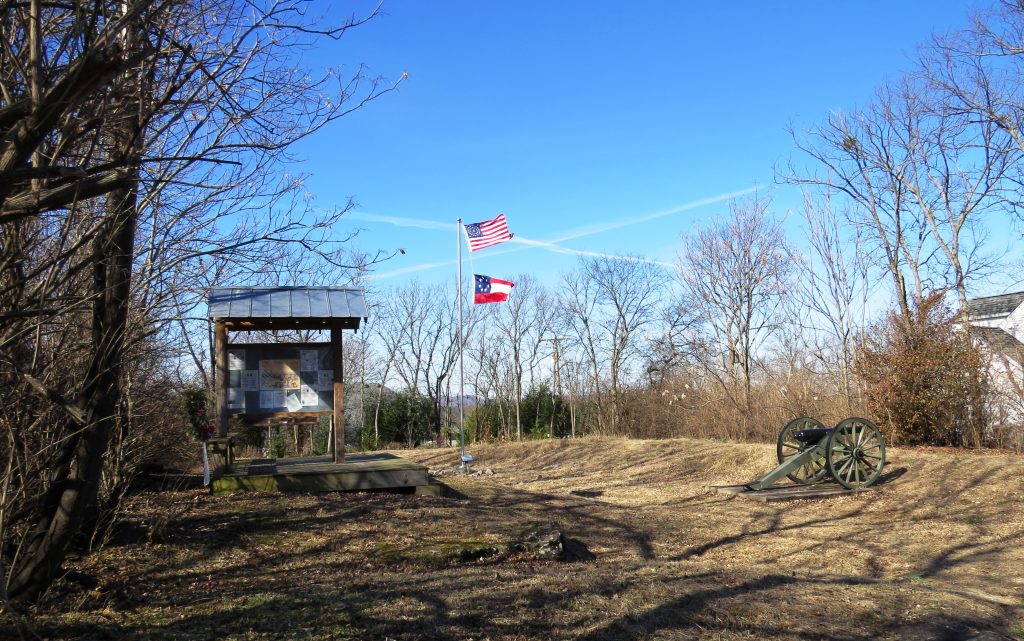 The Story
The Story
Redoubt No. 1 saw action on the first day of the Battle of Nashville, Thursday, December 15, 1864. It was the northern-most earthen fort of the five similar structures constructed by the army of Gen. John Bell Hood after their arrival in the Nashville area on December 2, following the devastating battle in Franklin on November 30 which had cost them about 7,000 casualties.
The earthworks system which included the redoubt was constructed over a 12 day period under extremely difficult conditions, as Middle Tennessee had been hit on December 8, 1864, by a winter storm that dropped the temperature to 10 degrees along with snow and a coating of ice, making entrenchment virtually impossible for days. Some accounts show a temperature of only 13 degrees as late as December 13. As a result, construction of the redoubts was only partially completed.
At the time of battle, the redoubt consisted of earthen walls reinforced with heavy timbers. There are no known photographs or contemporary drawings of the fort. Based on general knowledge and observation, it was significantly larger than the one-half acre remnant preserved on Benham Avenue. This area of the Confederate line was under the command of Maj. Gen. William Loring, commanding a division of Lt. Gen. Alexander P. Stewart’s Corps. It was manned by approximately 200 troops, about half of which would have included artillerymen managing a battery of four Napoleon smoothbore artillery pieces. About 100 infantry were present to support the battery and defend the fort.

Above: Artistic rendering of Redoubt No. 1, showing the interior of the works as well as a view over the wall, with landmarks labelled, by former BONT President Philip Duer
Redoubt No. 1 was the closest of the five redoubts to the huge Union guns at Fort Negley, about three and a half miles to the north in Nashville. It commanded a broad sweeping view of its surrounding area, including some buildings in Nashville and the high ground to the north, known as Montgomery Hill. It was positioned at a “corner” of the Confederate line, the main part of which arced eastward and northeasterly to Granbury’s Lunette almost five miles distant. The line was “refused” southward from the redoubt through what is now Green Hills Mall, roughly paralleling the Hillsboro Pike, which was in existence at the time.
Within the Union military command, there was significant disgruntlement on the part of high-ranking officers, especially Gen. Ulysses Grant, as to why Gen. George Thomas, commander of Union forces in Nashville, had not attacked Hood sooner. Among other issues, the coating of ice and deteriorating weather conditions played a major role in this delay, but a thaw had begun on December 14, and from his headquarters at the St. Cloud Hotel in Nashville, Gen. Thomas finalized his orders for the next day’s assault of the Confederate line.
When the action began on December 15, Gen. Thomas’s army launched a diversionary attack on the far right, or eastern, flank of the Confederate line, in the area of Granbury’s Lunette. That action, as well as all military activity, was delayed by a heavy ground fog that morning. Skirmishing began in the area of the Lunette around 8:00 a.m., but it was mid-morning before Union forces began executing the main attack. It consisted of a wide wheeling action in which both infantry and cavalry forces swung well out to the west and then south of the entrenched Confederate forces of Stewart’s Corps.
Though exact numbers are difficult to ascertain, the entrenched Army of Tennessee under Gen. Hood was about 25,000 strong; the U.S. Army was approximately three times that size, though Gen. Thomas probably only mobilized about 55,000 troops for the attack on December 15. Thomas, 48, watched the action unfold from high ground north of Montgomery Hill, where he had a panoramic view of the battlefield; Hood, 33, was doing the same from the top of Shy’s Hill to the south.
During this time, the big guns at Fort Negley, as well as other artillery emplacements in the field and smaller Union fortresses, were booming out over the expanse between Nashville and the Confederate line. Also on the high ground just outside of the city was a large audience of Nashvillians who came out to watch the action. One of Gen. John Schofield’s commanders recorded that the citizenry “came out of the city in droves. All the hills in our rear were black with human beings watching the battle, but silent. No army on the continent ever played on any field to so large and so sullen an audience.”

The main frontal assault targeted the refused Confederate line running south from Redoubt No. 1. Significant artillery fire and close combat erupted from the west, first at Redoubt No. 4 and then No.5, about one and a half miles to the south of Redoubt No. 1, and the flow of Union troops moved steadily northward to clash at Redoubt No. 3 and then No. 2. Much of this overwhelming attack could probably be seen by the men defending the high salient of Redoubt No. 1, but that Blue wave was not their only concern. The Union army was also closing in quickly on the fort from the north and northwest, having fought their way through thawing mud and skirmishers on Montgomery Hill during the day, and were preparing an assault up the steep and brush-strewn northern slope to the redoubt.
The IV Corps under Brig. Gen. Thomas J. Wood eventually moved into position below the redoubt to the north and northwest with three divisions, commanded by Brig. Gens. Washington Elliott, Nathan Kimball and Samuel Beatty. Their progress during the day had been slowed considerably by the three Napoleons at Redoubt No. 1 (one of the battery’s guns had been moved out of the redoubt earlier in the day to help defend the Union forces charging from the west). In his report, Wood famously wrote that the Redoubt guns “had been seriously annoying us all day.” In response, he had two batteries of artillery, each consisting of six guns with rifled barrels, brought up to pound the redoubt from converging angles at close range, doing considerable damage at the embrasures and killing and demoralizing the troops.
The final assault on the redoubt’s steep grade began at approximately 4:00 in the afternoon of a dark, cloudy day. The day-long momentum of the Union forces, plus the gradual wearing down of the Confederate line, resulted in a reasonably quick capture by multiple components of both Wood’s IV and Smith’s XVI Corps. Because numerous Federal units essentially arrived within the works at the same time, Field reports varied as each attempted to take credit for the capture.
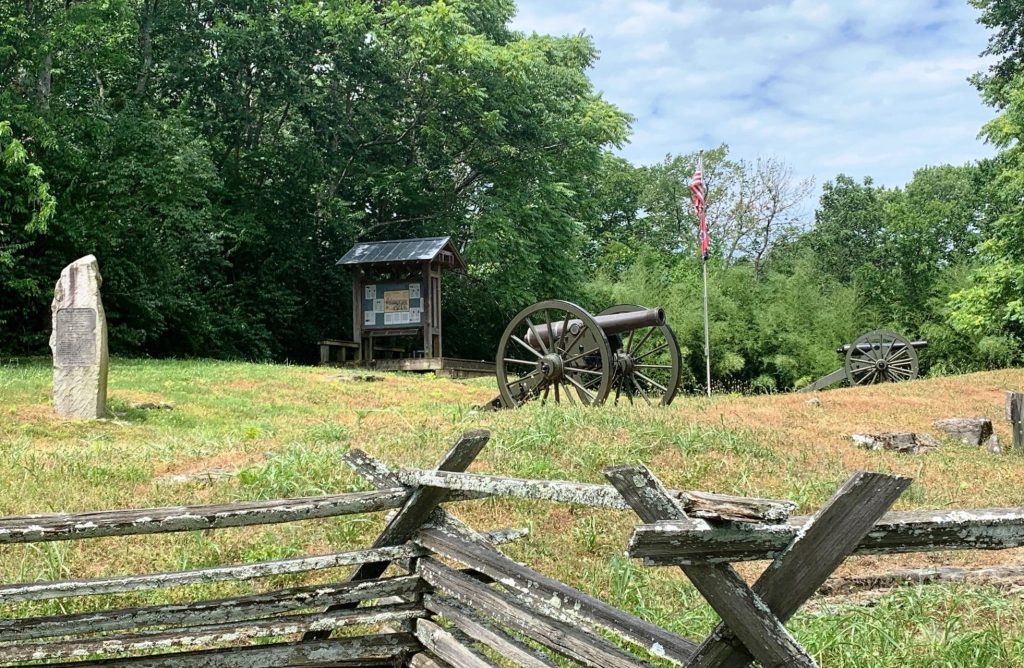 Above: Redoubt No. 1 showing Napoleon cannon replica placed by BONT in June, 2020, joining the previously-placed 3-inch Ordnance Gun
Above: Redoubt No. 1 showing Napoleon cannon replica placed by BONT in June, 2020, joining the previously-placed 3-inch Ordnance Gun
Kimball’s Division of Wood’s Corps, charging uphill from the north, received the official recognition. However, various elements of Elliott’s Division, charging from the northwest, claimed the win also. Elliott reported his division’s victory of the redoubt, as a unit, in great detail, but one of his skirmishers, Lt. William Hall of the 36th Illinois, claimed that he had led a band of about two dozen men in a sneak attack along a stone wall on the west side of Hillsboro Pike and took the redoubt by surprise from the rear. Smith’s XVI Corps, fresh from overtaking Redoubts 3 and 2, claimed a piece of the prize from the southwest side.
The confusion brought about by the simultaneous convergence of different units from multiple directions created this controversy, but by most accounts the Confederate line was already giving in to the overwhelming pressure of the assault and had begun to drop back.
As darkness came, the remainder of the Confederate line, following the collapse of Stewart’s Corps on the left flank, fell back to the south to reestablish new positions primarily stretched along current Harding Place and Battery Lane, and anchored on the west by Compton’s (now Shy’s) Hill and on the east at Peach Orchard Hill. Following its capture, the Redoubt was used as a field hospital.
For examples of more comprehensive readings regarding this part of the Battle, see Stanley F. Horn, The Decisive Battle of Nashville (1956), and the more recent fact-filled book by James Lee McDonough, Nashville: The Western Confederacy’s Final Gamble (2004), both of which were used as sources for the summary above.
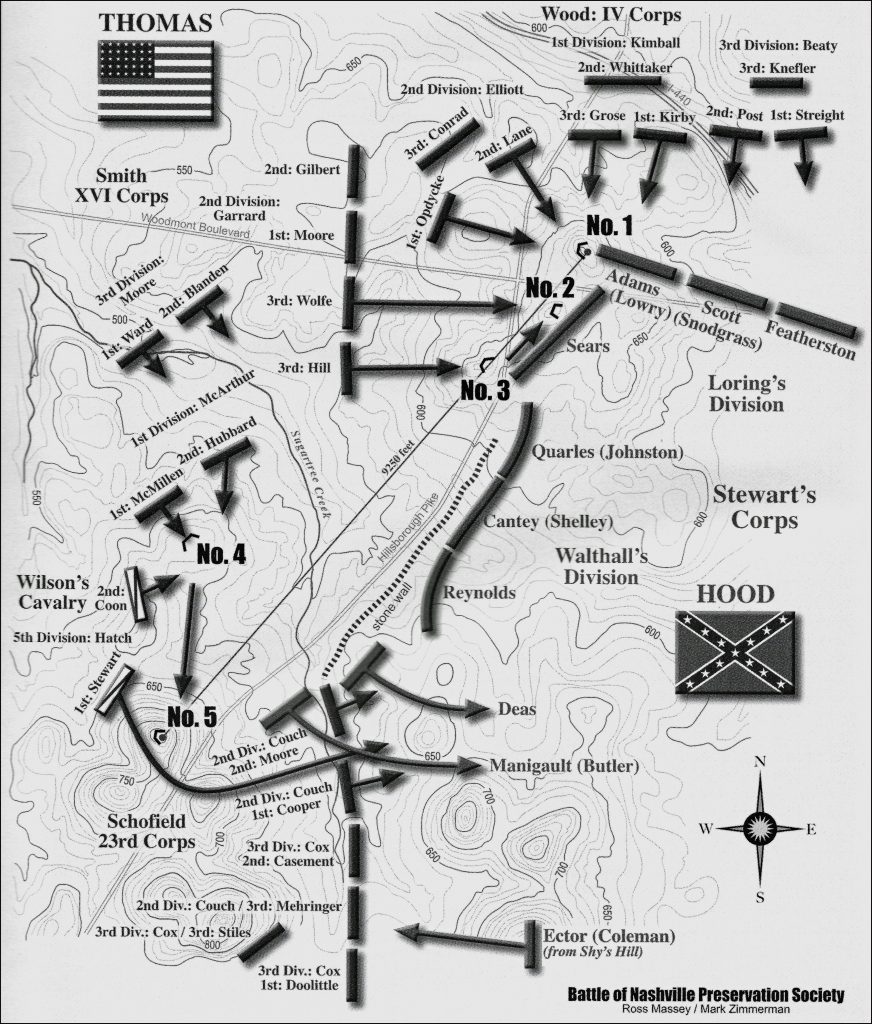
Above: Map courtesy of Guide to Civil War Nashville, a comprehensive tour guide to the Battle of Nashville sites. Map created by author Mark Zimmerman in conjunction with historian Ross Massey. First published in 2004, the 2nd edition was published in 2019. Click here for more information.
Redoubt No. 1 Now. This redoubt is one of the last remaining sites of the Battle of Nashville and, along with Shy’s Hill, has been preserved, enhanced, and interpreted by the Battle of Nashville Trust. The Battle of Nashville Trust, Inc. owns the property on which Redoubt No. 1 is located, after purchasing the site in 2009. It is protected by a conservation easement through the Land Trust For Tennessee in order to prevent future development.
Former BONT president Philip Duer has rendered an excellent illustration of the Redoubt as it may have appeared in December of 1864, depicting its construction and the views of the surrounding territory from its high point.
Visiting Redoubt No. 1
Directions. Redoubt No. 1 is located a few hundred feet north of Woodmont Boulevard at 3423 Benham Avenue in the Green Hills community of Nashville. From I-440, exit south on Hillsboro Road and travel south to Woodmont Blvd. Turn left onto Woodmont, then turn left onto Benham Ave. to the split rail fence and historical marker a short distance on the left. For Google map directions, click here.
Admission. Free to the public. The site is open from dawn to dusk. Parking space is extremely limited; large vehicles may not be feasible. Redoubt No. 1 is located in a residential neighborhood. During your visit, please take care to respect the privacy and property of the nearby property owners.
Monuments and related structures. BONT has placed an interpretative Kiosk on the grounds, complete with maps and description of the battle; a flagpole flying flags representing the combatants; and an artillery field piece located at the North wall, pointing in the direction of the principal attack by Wood’s IV Corps. For many years, a reproduction 3-inch ordnance gun was positioned at the wall remnant and was representative of artillery placement during the battle. In June, 2020, BONT added a larger smooth-bore Napoleon cannon, four of which were included in the Redoubt battery in December, 1864. Click here for a story about the history and placement of the Napoleon.
Special reminder to our visitors. BONT asks each visitor to remember that Redoubt No. 1 is a historic Civil War field of battle, and therefore, is “hallowed ground” on which men of the Union and Confederacy were killed or wounded on December 15, 1864. Please honor and respect their memory, the battlefield grounds on which they fought, and the historical significance of the event that occurred here when you visit.
Metal detecting and related activity. The possession and use of metal detectors for the purpose of relic hunting on Redoubt No. 1 property, as well as theft or damage relating to its structures and monuments, are strictly prohibited and violators will be prosecuted.
June 13, 2020
A NAPOLEON SMOOTHBORE CANNON RETURNS TO REDOUBT NO. 1 AFTER 155 YEARS
The Napoleon that once stood sentinel on the summit of Shy’s Hill is now back on duty, this time at Redoubt No. 1 — the first of its kind to guard the Redoubt since the battle there on December 15, 1864.
On June 13, 2020, a small contingent of the BONT Board moved the reproduction smooth-bore from its interim position at the home of Jim Kay, president of BONT, to the Redoubt. There, it joined up with the reproduction field piece, a 3-inch ordnance gun, that has stood at the wall for many years.
 Above photos by Sidney McAlister
Above photos by Sidney McAlister
The Napoleon is more representative of actual conditions at the redoubt, which was designed to hold a battery of four of the big smoothbores. This area of the Confederate line was under the command of Maj. Gen. William Loring in Lt. Gen. Alexander P. Stewart’s Corps. The Redoubt was manned by approximately 200 troops, about half of which would have included artillerymen managing the guns. About 100 infantry were present to support the battery and defend the fort.
The Napoleon had been an important attraction at Shy’s Hill for more than a decade, but eventually deteriorated due to weather and had to be removed. It has now been rebuilt and was too heavy to replace on the summit. In addition, its original placement had been symbolic only, as there was no artillery at the summit during that battle on Dec. 16, 1864.
After the Napoleon was removed for rehab, BONT placed two replica field Howitzers on a flat “plateau” near the bottom of the eastern slope of Shy’s Hill, accurately reflecting the position of the few guns that could be readied for action on December 16. The Howitzers were part of the command of Capt. Rene T. Beauregard, son of Gen. P.G.T. Beauregard, and were later supplemented by several other field pieces.
The cannon was the inspiration behind graphic artist Elizabeth Harbin’s design of the new logo for the Battle of Nashville Trust in 2020.
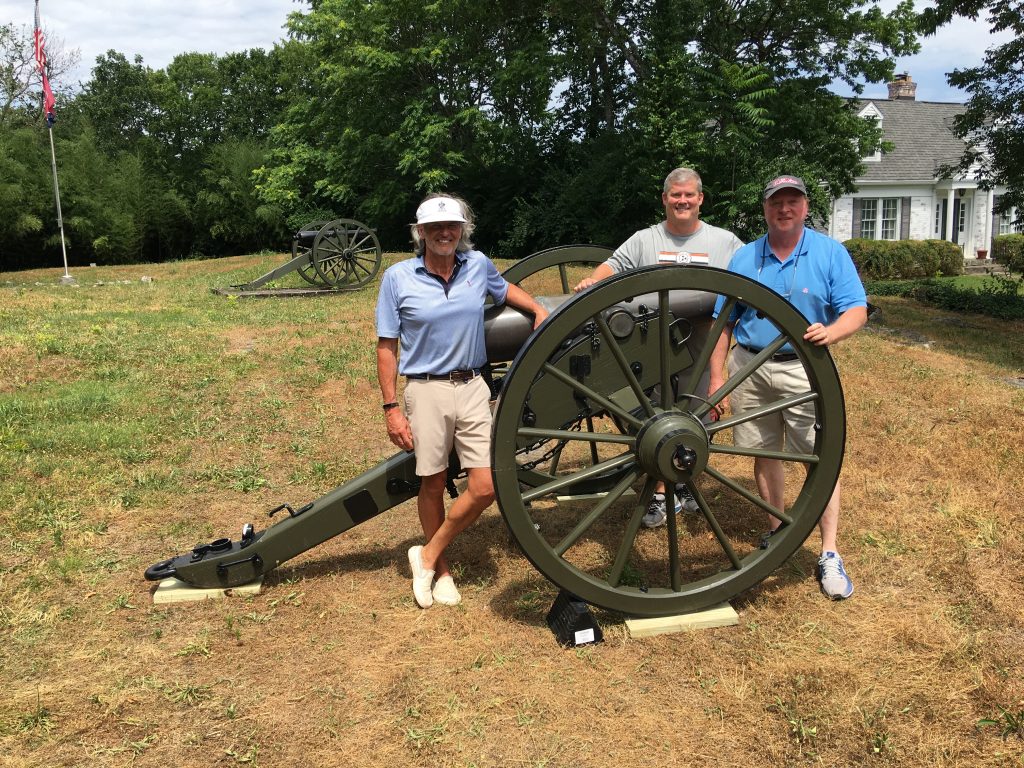 Above: BONT Board members Jim Kay, Bobby Whitson, Sidney McAlister, and Mark Zimmerman (taking photo)
Above: BONT Board members Jim Kay, Bobby Whitson, Sidney McAlister, and Mark Zimmerman (taking photo)
September, 2021
SMOOTHBORE ARTILLERY PIECE DONATED TO BONT, TO BE OUTFITTED FOR DISPLAY ON NASHVILLE BATTLEFIELD SITE
The Battle of Nashville Trust (BONT) has been gifted with a reproduction 6-pounder field artillery piece based on those manufactured during the Civil War by the famous Noble Brothers Foundry of Rome, Georgia.
The cannon was donated by Ms. Graham Woolwine-Gilson, a Nashville native now living in Mamer, Luxembourg. When displayed by BONT, the cannon will be accompanied by a bronze plaque stating, “Donated in memory of Porter Anthony (Tony) Woolwine.”
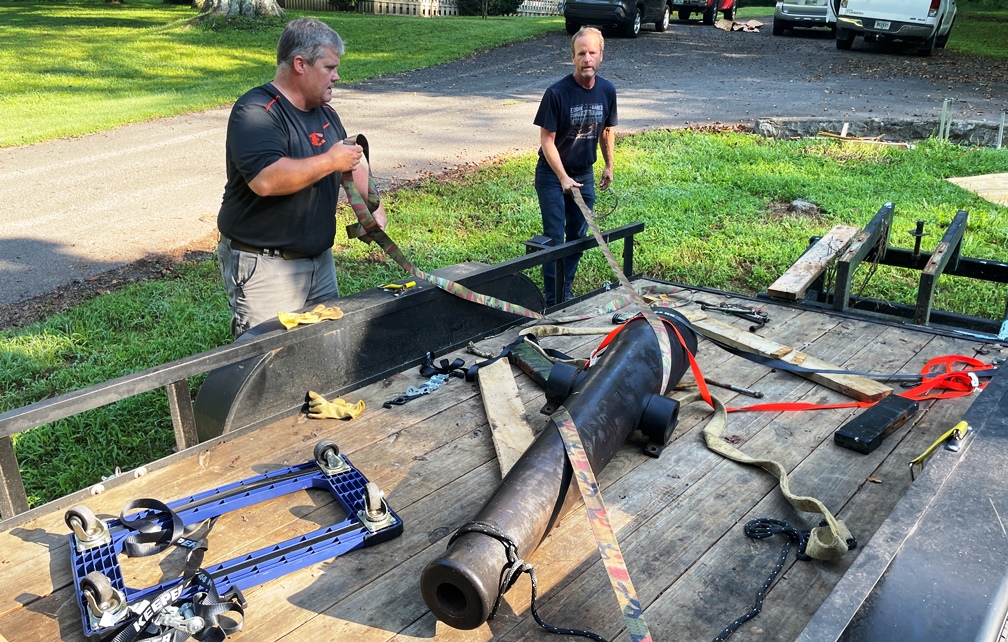
BONT Board members Bobby Whitson and Pete McAlister prep cannon for delivery to Commercial Painting Inc. Photo by Mark Martin
The gift consists of a replica 6-pounder iron cannon tube designed to resemble those manufactured by Noble Brothers, a large ironworks factory in Georgia producing pre-war items such as steam boat engines, locomotives and furnaces. During the war, it turned some of its production to cannons for the Confederacy. The factory was burned to the ground by Gen. William Tecumseh Sherman in 1864, with nothing remaining except the huge lathe machinery used in cannon production.
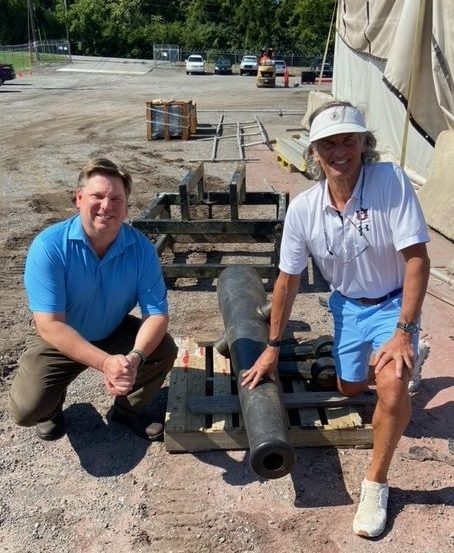
Commercial Painting CEO Jon Petty (L) and BONT President Jim Kay (R), after the Noble Brothers tube had been delivered to prepare it for display.
In his letter accepting the canon barrel on behalf of BONT, President Jim Kay expressed special thanks and noted that it would be placed on “one of the battlefield properties for all to enjoy for decades in the future,” and that “it is people like you that make a difference in what we do.”
The cannon tube, weighing close to 1,000 pounds, was transferred by BONT board members Bobby Whitson, Mark Martin and Pete McAlister from its location in Nashville to Commercial Painting, Inc., where it will be sand-blasted and re-painted.
Afterwards, it will have to be mounted on a custom-built carriage in order to be placed, according to current plans, at BONT’s Redoubt No. 1 preservation site on Benham Avenue.
The muzzle-loading 6-pounder field gun was so-named because it was designed to fire a 3.58 inch-in-diameter round shot that weighed approximately 6 pounds for a range of about 1200 to 1500 yards, depending upon the type of shot used. In addition to solid shot, it could also fire case and canister. It was largely replaced by the U.S. Army early in the war with more advanced artillery, such as the 12-pounder Napoleon smoothbore, but was in use for a longer period by the Confederate armies.
More photos of Redoubt No. 1
- The view north from Redoubt 1
Redoubt No. 1 was featured on the Summer 2004 cover of Hallowed Ground, the magazine of the Civil War Preservation Trust. The CWPT held their annual conference in Nashville in 2004.
